Biologist Claudio Monteza pushed through thick vegetation to install a camera near a Panamanian highway in a dense tropical rainforest. Securing the device to a tree just off the forest floor, he checked its field of vision.
The camera and others were set up to provide insights into which animals steer clear of highways and which ones are more apt to check them out. The findings could someday help transportation officials better protect wildlife in one of the world's most biologically diverse environments.
But the highway study “was not the initial plan,” said Monteza, whose career was upended last year when COVID-19 stranded him in his native Panama and suspended his research. Because of the pandemic, many scientists "have had to innovate and look for alternatives.”
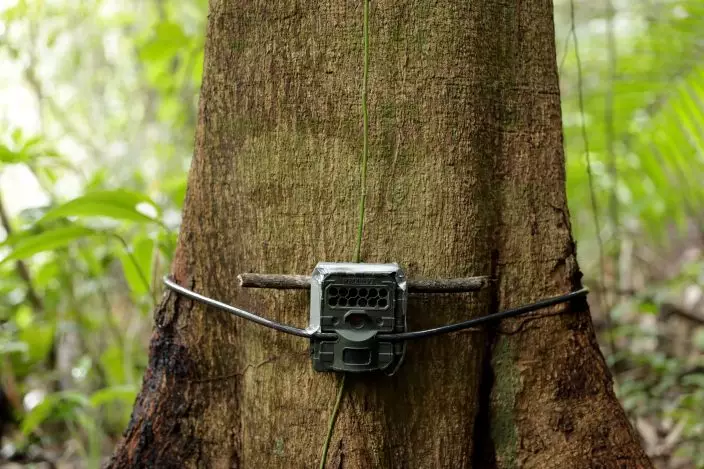
A camera trap installed by biologist Claudio Monteza is fastened to a tree just off the forest floor in San Lorenzo, Panama, Tuesday, April 6, 2021, amid the new coronavirus pandemic. Monteza hopes his series of cameras will provide insights into which animal species steer clear of highways and which ones are more apt to check them out. (AP PhotoArnulfo Franco)
The coronavirus abruptly halted research by many Latin American scientists, interrupting field work, sample collection and laboratory experiments. Some of them could focus on writing scholarly articles based on previous research, but others had to get creative to avoid losing a year of their careers.
Monteza had just finished a master’s degree in the United States when he stopped in Panama for a few days before a planned flight to Germany to begin his doctoral studies. Then the world began shutting down. He started taking doctoral classes virtually.
After governments adopted strict quarantine measures, Monteza concluded that one way to get permission for research was to look at highways because they could be studied without significant travel.
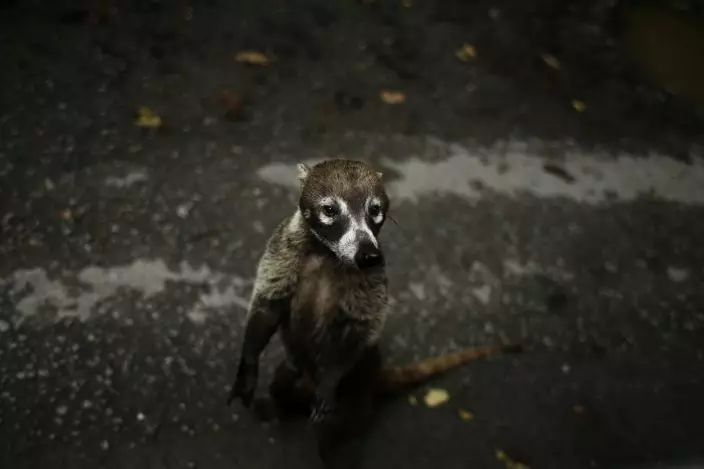
A Coati, a diurnal mammal native to South America, Central America, Mexico, and the southwestern United States, stands on the side of a road after biologist Claudio Monteza installed a set of camera traps in the dense tropical rainforest in San Lorenzo, Panama, Tuesday, April 6, 2021. Monteza has shifted his research to accommodate the COVID-19 pandemic restrictions and has been taking his doctoral classes virtually. (AP PhotoArnulfo Franco)
Other scientists hauled samples of marine sediment and lab equipment or even entire ant colonies into their homes. One researcher, barred from capturing bats to bring to her laboratory, mounted cameras that allowed her to spy on their sexual habits in the wild.
On a recent day, after installing one camera, Monteza pushed about 50 yards deeper into the forest. Field biologist Pedro Castillo helped him install another camera just as heavy raindrops began to fall. In minutes, both men were soaked, but the opportunity to get into the field was a relief.
Monteza believes the highway research could help push authorities to create wildlife crossings for armadillos, the rodents known as lowland pacas and agoutis, and other animals.
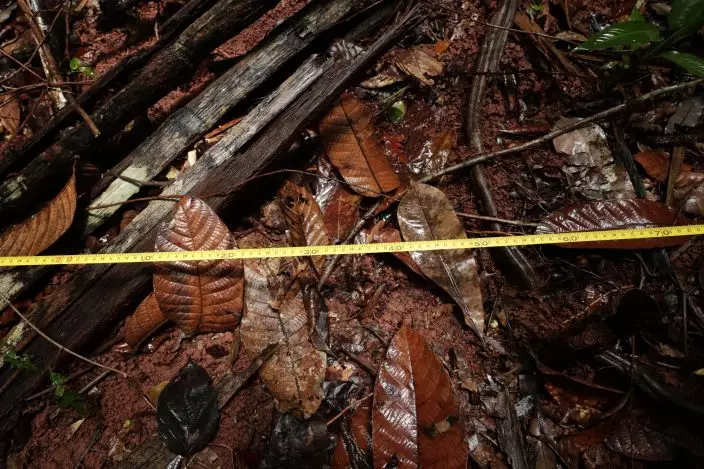
A tape measure is stretched across the forest floor as biologist Claudio Monteza installs one of his remote camera traps in the tropical rainforest in San Lorenzo, Panama, Tuesday, April 6, 2021. A year ago, Monteza had just finished a master's degree in the United States and was stopping by his native Panama for a few days before flying to Germany to begin his doctoral studies when the COVID-19 pandemic stranded him. (AP PhotoArnulfo Franco)
During the first half of 2020, when Panama was under an absolute quarantine, scientists had almost “zero mobility, said Erick Núñez, head of the Panama Environmental Ministry’s biodiversity department. "There was very little research.”
Later, the Health Ministry began to loosen restrictions and granted passes to some scientists who planned to work in protected areas alone or in small groups, Núñez said.
Researcher Brígida De Gracia of the Smithsonian Tropical Research Institute was lucky to be able to work from home. She had collected sediment samples in 2018, 2019 and January 2020 that allowed her to continue her research during the pandemic.
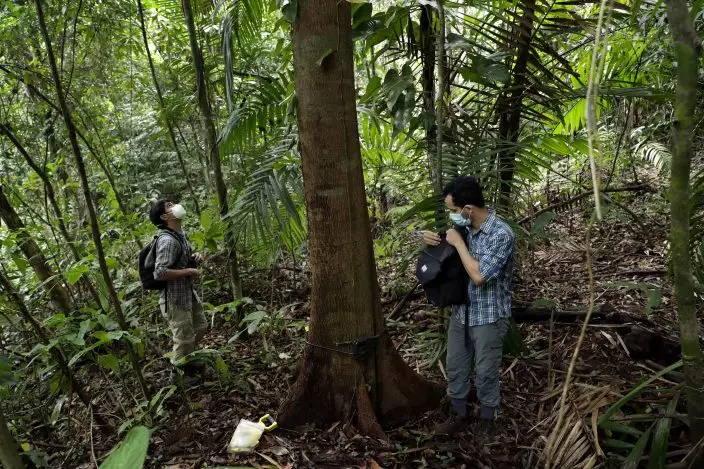
Biologists Claudio Monteza, right, and Pedro Castillo install a remote camera trap on a tree in the rainforest in San Lorenzo, Panama, Tuesday, April 6, 2021, amid the new coronavirus pandemic. "This study was not the initial plan," Monteza said. "But because of the pandemic a lot of us have had to innovate and look for alternatives. (AP PhotoArnulfo Franco)
But to do so, De Gracia took the samples, a stereoscope, vials, a scale and many books home from her lab in Naos, near where the Panama Canal meets the Pacific Ocean.
De Gracia studies otoliths, tiny stone-like structures in the ears of many vertebrates. In particular, she studies them in fish to see how humans have affected fish over the past several thousand years.
“You have to store them very carefully,” because they’re so tiny that even a light breeze can move them, said De Gracia, who analyzed and photographed the otoliths at home.
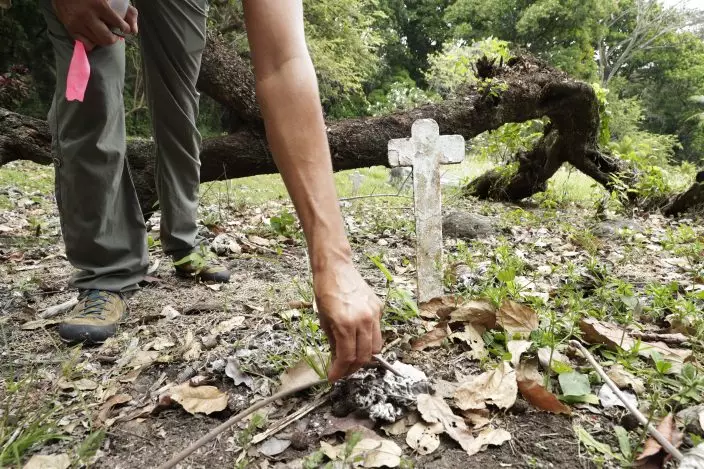
Dumas Galvez, a researcher of the Smithsonian Tropical Research Institute, leaves oats for ants at the French Cemetery in Paraiso, Panama, Tuesday, March 30, 2021. After a year, Panama has loosened its COVID-19 pandemic restrictions and the Smithsonian is in the process of reopening its facilities there, so Galvez has been able to do fieldwork and supervise students. (AP PhotoArnulfo Franco)
Before the coronavirus arrived, Mariana Muñoz-Romo, a post-doctoral researcher at the Smithsonian, had planned to capture a large sample of bats from different places around the Panamanian town of Gamboa, but the suspension of research activities made that impossible.
So she adjusted. Instead of catching bats to take back to a lab, Muñoz-Romo shifted to observing the bats’ sex lives in their own habitat. She hopes to discover the purpose of a strong-smelling substance on the forearms of the fringe-lipped bat.
Her mentor was able to get permits to install video cameras and other devices in a bat sanctuary in Gamboa. They started recording in mid-2020 and plan to continue for several more months.
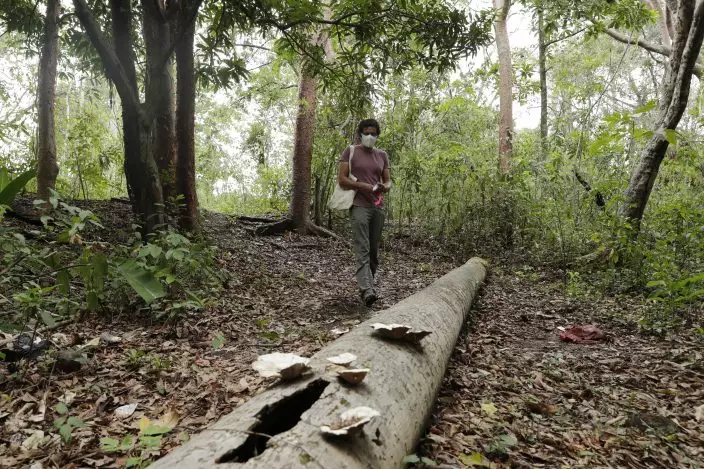
Dumas Galvez, a researcher of the Smithsonian Tropical Research Institute, walks in a forest searching for ants, near his home in Paraiso, Panama, Tuesday, March 30, 2021. When his laboratory in Gamboa closed due to the COVID-19 pandemic, Galvez moved dozens of ant colonies to his home in Paraiso to continue his research. (AP PhotoArnulfo Franco)
“Analyzing these recordings is fabulous because you can generate a mountain of information,” said Muñoz-Romo, a Venezuelan who is a professor at the University of the Andes in Merida, Venezuela.
When the pandemic closed his laboratory in Gamboa, Dumas Gálvez moved dozens of colonies of ants to his home in Paraiso. He wanted to continue observing them as part of his research into their immune systems.
Before the pandemic, that required many hours in his lab analyzing their blood and how they responded to attacking fungi.
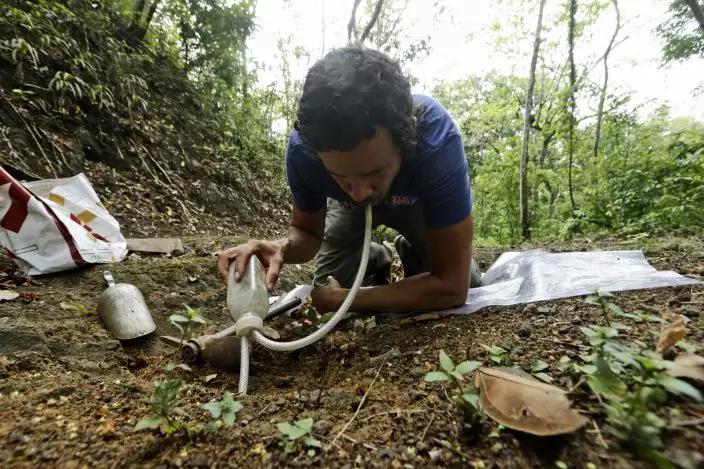
Dumas Galvez, a researcher of the Smithsonian Tropical Research Institute, collects ants from a nest in Paraiso, Panama, Tuesday, April 13, 2021. Before the COVID-19 pandemic, Galvez spent many hours in his lab analyzing their blood and how they responded to attacking fungi. (AP PhotoArnulfo Franco)
“I had to look for alternatives,” Gálvez said. “And one of the alternatives was initially to do it in my house.”
Gálvez outfitted an extra bathroom to hold up to 100 ant colonies. His largest colonies were around 200 ants, so he had an estimated 13,000 ants in his home.
He observed their lives and reactions for months, but over time they began to die. Exactly why was not clear. It was either because of the fungus or excessive heat, he said.
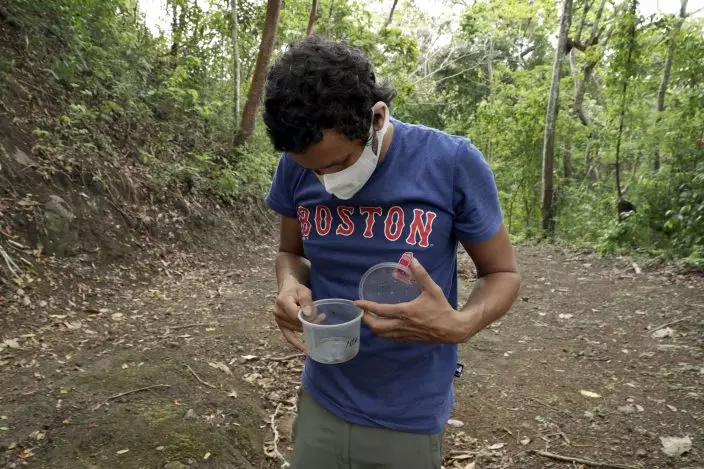
Wearing a mask to curb the spread of the new coronavirus, Dumas Galvez, a researcher of the Smithsonian Tropical Research Institute, looks at ants he collected from a nest in a forest near his home in Paraiso, Panama, Tuesday, April 13, 2021. Galvez outfitted an extra bathroom at his home to hold between 70 and 100 ant colonies. The ants that Galvez studies do not live in colonies as big as others. His largest colonies were around 200 ants, so he estimated he had about 13,000 ants living in his home. (AP PhotoArnulfo Franco)
“The conditions in the bathroom were not optimal," he said. "It was very hot. They dried quickly.”
The pandemic prevented him from going out to collect more ants, so he shifted his focus and is now studying the interaction of ants and a small predatory frog.
Panama has since eased its pandemic restrictions, and the Smithsonian is reopening its facilities there. Gálvez has been able to resume field work and supervising students.
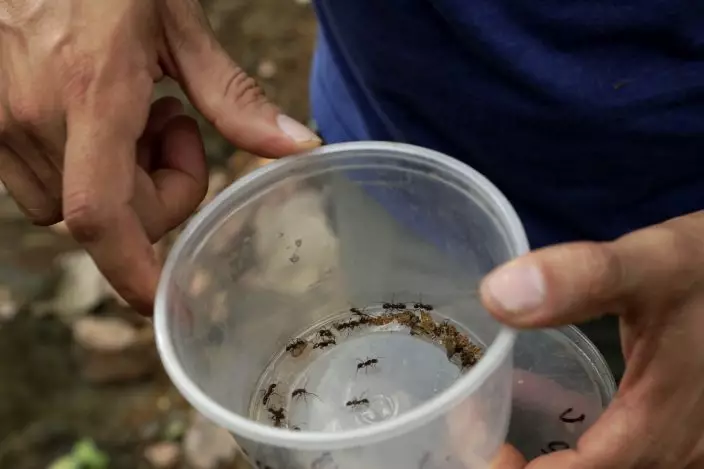
Dumas Galvez, a researcher of the Smithsonian Tropical Research Institute, holds a container with ants he collected from a nest in a forest near his home in Paraiso, Panama, Tuesday, April 13, 2021. With plenty of time to review existing literature on ants during the restrictions due to the COVID-19 pandemic, Galvez found there was relatively little field research on ants. (AP PhotoArnulfo Franco)
“If not for the pandemic, I wouldn’t have invested the energy in considering alternatives,” he said. “I probably would not have ever done this project.”
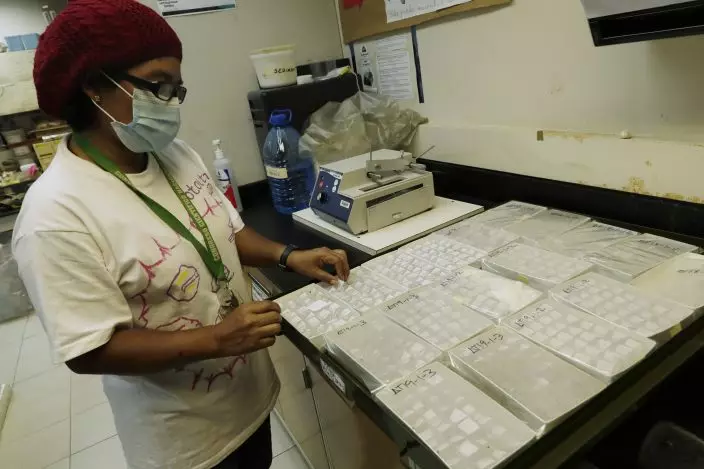
Researcher Brigida De Gracia of the Smithsonian Tropical Research Institute, holds a sample of fish otoliths at the Naos Marine Laboratories in Panama City, Wednesday, March 31, 2021, that she classified while in her home due to the COVID-19 pandemic lockdown. De Gracia studies otoliths, a tiny stone-like part of the anatomy of vertebrates found in their inner ear. In particular, De Gracias studies them in fish as part of her efforts to see how humans have been impacting fish over the past several thousand years. (AP PhotoArnulfo Franco)
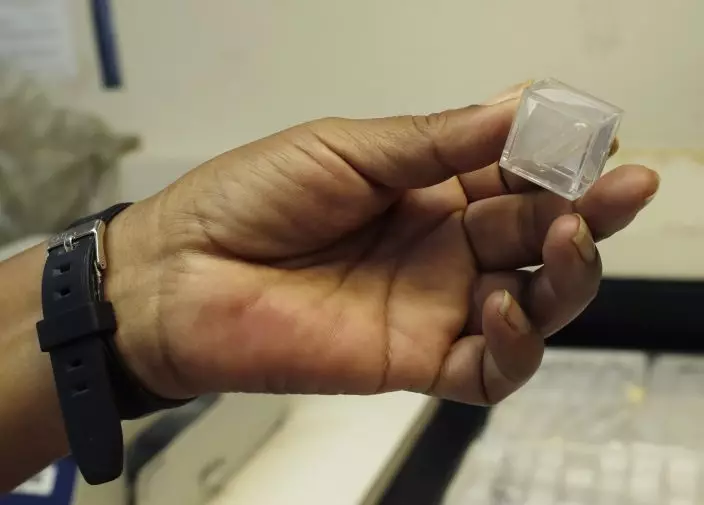
Researcher Brigida De Gracia of the Smithsonian Tropical Research Institute, holds a sample of fish otoliths at the Naos Marine Laboratories in Panama City, Wednesday, March 31, 2021, that she classified while in her home due to the COVID-19 pandemic lockdown. “Right now we are seeing that icthyofauna (fish) are changing under human pressures of fishing, pollution,” De Gracia said. (AP PhotoArnulfo Franco)
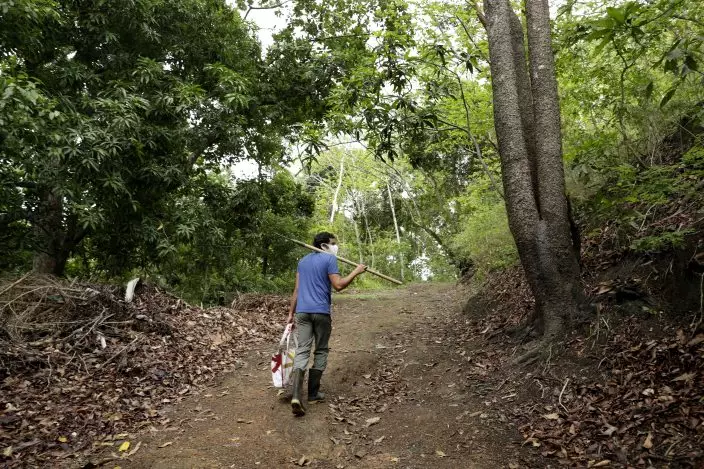
Biologist Dumas Galvez walks along a trial in a forest near his home while looking for ant nests in Paraiso, Panama, Tuesday, April 13, 2021. With plenty of time to review existing literature on ants during the new cornavirus pandemic lockdown, he's now studying the interaction of ants and a small predatory frog. (AP PhotoArnulfo Franco)


